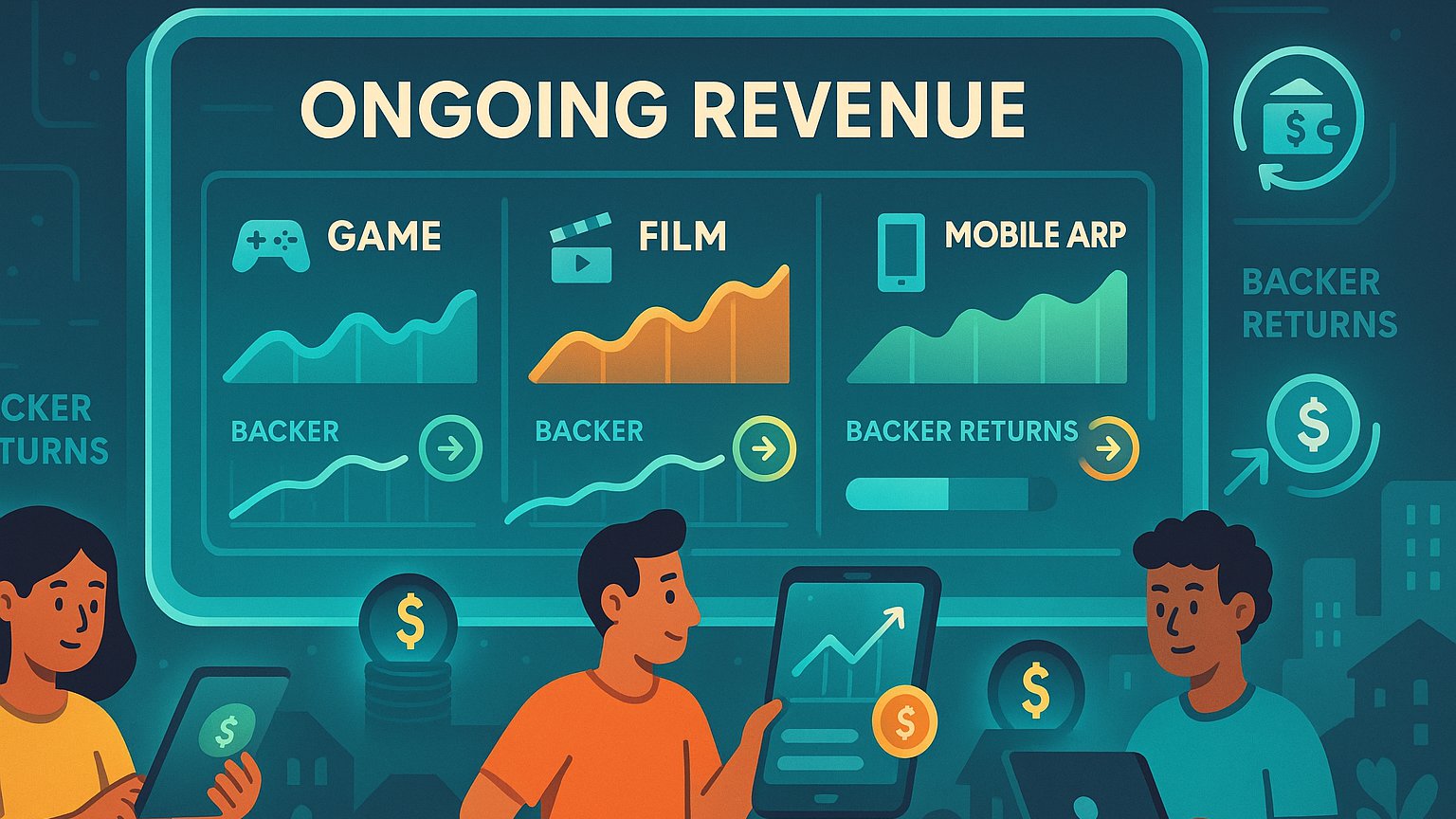Royalty and Revenue Sharing Crowdfunding: Invest in Creativity, Profit from Potential
Imagine earning income every time a hit song plays on Spotify, a bestselling book sells another copy, or a fast-growing startup closes a sale. Welcome to the bold, collaborative world of royalty and revenue sharing crowdfunding—where creators share future earnings with investors who help them bring ideas to life. This isn’t just supporting a dream; it’s owning a slice of its success.
Unlike traditional equity or donation-based crowdfunding, this model ties investment returns directly to the future revenues of a product, project, or company. It’s a win-win scenario. Creators get capital without giving up equity, and investors receive a steady stream of income based on actual performance.
Whether you’re a musician funding your next album, a startup monetizing future sales, or an investor looking to back scalable creative ventures, this guide takes you through the exciting ecosystem of revenue sharing crowdfunding.

Investors in Royalty and Revenue Sharing Crowdfunding
Step into the future of investing where every stream, sale, or song can turn into a steady flow of returns. Royalty and revenue sharing crowdfunding is unlocking exciting new paths for investors who want more than just equity—they want a direct piece of the action. From indie films and blockbuster music to bestselling books and booming startups, this model invites you to earn real-time, recurring income based on actual revenues.

Creators in Royalty and Revenue Sharing Crowdfunding
Imagine funding your next big idea by offering fans and supporters a share in your actual revenue—not just a thank you. Royalty and revenue sharing crowdfunding flips the script on traditional fundraising, empowering creators to raise capital while giving backers a cut of the profits. Whether you’re a musician ready to drop your next album, a filmmaker pitching a bold new story, or an entrepreneur launching a product with serious

Platform Options in Royalty and Revenue Sharing Crowdfunding
Welcome to the gateway of modern funding—where platforms empower creators and investors to connect through revenue-sharing deals that bring value to both sides. Royalty and revenue sharing crowdfunding platforms are transforming how projects get funded, turning fans into financial partners and ideas into sustainable income streams. Whether you’re launching a new app, producing a music album, or bringing a blockbuster script to life, the right platform can amplify your reach

Model Overview in Royalty and Revenue Sharing Crowdfunding
Step into a crowdfunding model where success is truly shared. Royalty and revenue sharing crowdfunding offers a dynamic alternative to traditional investment. Instead of giving away ownership or relying on perks, creators raise funds by promising backers a percentage of the revenue their project generates. From films and albums to tech products and intellectual property, this model opens the door to recurring income and deeper alignment between creators and their

Music and Entertainment in Royalty and Revenue Sharing Crowdfunding
What if you could help launch the next chart-topping hit or breakout indie film—and get paid when it succeeds? Royalty and revenue sharing crowdfunding in music and entertainment is revolutionizing how creative projects come to life. Artists and producers now invite fans and investors to play a direct role in funding albums, shows, movies, podcasts, and more—offering a cut of future revenues in return. It’s not just support; it’s partnership,

Revenue Share Terms in Royalty and Revenue Sharing Crowdfunding
In the world of royalty and revenue sharing crowdfunding, the real magic happens in the numbers—specifically, how revenue is divided and shared. This model thrives on transparency and trust, where creators outline exactly how much of their future earnings will be distributed to backers, and investors know exactly what they’re signing up for. From fixed percentage splits to tiered payouts, the terms of the share are the foundation of any

Case Studies in Royalty and Revenue Sharing Crowdfunding
What does success really look like in royalty and revenue sharing crowdfunding? The answer lives in the stories of those who’ve already walked the path—creators who turned dreams into thriving projects and investors who saw returns from the art, innovation, and ideas they helped bring to life. Case studies give you the clearest window into what works, what doesn’t, and how strategy, storytelling, and transparency come together to produce powerful

Contracts and Legal in Royalty and Revenue Sharing Crowdfunding
Behind every successful royalty and revenue sharing crowdfunding campaign is a rock-solid contract—the blueprint that defines how money flows, rights are shared, and trust is protected. Whether you’re a creator offering a percentage of future revenue or an investor looking to secure your stake, the legal side of this model is where clarity meets opportunity. Getting it right means unlocking smoother campaigns, stronger relationships, and reliable returns for everyone involved.
For Creators: Funding Without Giving Up Control
One of the most attractive aspects of royalty and revenue sharing crowdfunding is that it lets creators access funding without surrendering ownership. This is especially appealing for artists, entrepreneurs, and innovators who want to maintain creative freedom or avoid dilution of equity.
Instead of offering rewards or equity stakes, creators agree to pay back a percentage of future revenue until a fixed return is met or for a certain time period. This structure can adapt to the natural rhythms of a business, allowing repayments to scale with success.
For creators in music, film, publishing, or digital startups, this means tapping into a supportive investor base that wants to see you succeed—not just for passion, but for profit. It also means building a tribe of stakeholders who have every reason to promote, share, and amplify your work.
To succeed in this space, creators need clarity, transparency, and a powerful pitch. You’re not just selling an idea—you’re inviting backers into a shared financial journey.
For Investors: Participating in the Revenue Stream Economy
For investors, revenue sharing crowdfunding offers something different from stocks or speculative crypto. It provides exposure to real income, grounded in real-world transactions. It’s an opportunity to participate in the earnings of projects you believe in, from the moment they begin generating cash.
Instead of waiting for a buyout or IPO, investors start receiving payments as soon as the project produces revenue. These distributions can come monthly, quarterly, or annually, depending on the structure.
Many investors love this model for its predictability and alignment. You’re not betting on long-term market value—you’re supporting creators with a clear path to monetization. That makes it perfect for those looking for alternative fixed-income streams, passive income, or mission-aligned investing.
It also adds a personal edge. There’s something thrilling about hearing a song you helped fund play on the radio, or seeing a product you backed fly off the shelves—knowing a portion of that success flows right back to you.
Model Overview: How Royalty and Revenue Sharing Works
At its core, royalty and revenue sharing crowdfunding involves creators offering a portion of their future income in exchange for upfront investment. There are a few common structures.
One model is capped revenue share, where creators agree to pay back investors until a fixed multiple is reached—say, 1.5x or 2x of the original investment. Once that target is met, the obligation ends.
Another model is term-based sharing, where the creator agrees to pay a percentage of revenue (such as 5–10%) for a defined period, like five years. Payments adjust with performance, and there’s no specific cap.
Royalty deals, particularly in entertainment, assign a share of royalties from a single asset—like a song, script, or book. These often track specific licensing deals, streaming royalties, or syndication income.
In all models, returns are performance-based. That means investors carry some risk—if the project flops, returns shrink. But if it soars, they share in the ride.
Music and Entertainment: The Original Home of Royalties
Nowhere is revenue sharing crowdfunding more vibrant than in music and entertainment. These industries run on royalties—streams, downloads, sync deals, and performance rights—making them a natural fit for investor-backed sharing.
Musicians use this model to fund albums, tours, or promotional campaigns. Instead of a traditional record label taking a huge cut, artists can raise funds directly from fans and investors, then share royalties over time. Filmmakers use revenue sharing to finance independent films, web series, and documentaries. Investors receive a percentage of box office sales, streaming licenses, or syndication rights. Authors, screenwriters, and podcasters have also stepped into the space. With self-publishing and direct distribution on the rise, creators are taking control—and inviting others to share the journey.
The emotional connection of these industries adds to the appeal. Investors aren’t just funding entertainment—they’re helping bring stories, sounds, and experiences into the world, while earning along the way.
Revenue Share Terms: Decoding the Deal Details
Understanding the terms of a revenue share deal is critical for both creators and investors. These agreements are structured to balance opportunity and protection for both sides.
Key terms include the percentage of revenue to be shared, the duration of the agreement, and the return cap if applicable. For example, a campaign might promise investors 10% of monthly revenues until they receive 1.8x their original investment.
Payment frequency is also a big factor. Some deals pay out quarterly, some only after certain revenue milestones. Others include “grace periods” that delay payments until certain sales thresholds are met.
Another consideration is gross vs. net revenue. Gross revenue sharing means investors get a percentage of total sales. Net revenue sharing subtracts costs first—which can significantly affect payouts.
Transparency is essential. A good campaign clearly outlines how revenue will be tracked, reported, and distributed. The best platforms enforce reporting standards and offer dashboards so investors can follow performance in real time.
Platform Options: Where Revenue Sharing Comes to Life
Several platforms have emerged as leaders in the revenue and royalty crowdfunding space, each with unique features and areas of focus.
Royalty Exchange is one of the most established names, allowing investors to buy royalties from existing catalogs—think songs by top artists or commercial jingles. It functions like a marketplace, where investors bid on real royalty streams.
WeFunder and Republic offer revenue share notes alongside equity options. These platforms are strong for startups and consumer product creators who want to raise capital without giving up ownership.
SongVest specializes in fractional ownership of music royalties, letting fans and investors purchase shares in new or established songs and albums. It’s a dynamic space that merges fandom with financial return.
Upright and StartEngine have also begun offering innovative variations of revenue share crowdfunding, from small business lending to film investments.
When choosing a platform, creators should consider audience size, legal support, marketing tools, and industry specialization. Investors should review platform fees, historical performance, reporting tools, and risk disclosures.
Contracts and Legal: Building the Backbone of Trust
The strength of a revenue share crowdfunding campaign lies in its legal structure. These deals must be airtight, fair, and fully transparent.
For creators, this means drafting clear contracts that outline obligations, triggers, payment schedules, and what happens if targets aren’t met. Legal advisors often help translate campaign promises into enforceable terms.
For investors, a strong contract protects your rights. It defines how and when you’ll be paid, what counts as revenue, and how disputes are handled. It also outlines termination clauses, reporting requirements, and any contingencies.
Regulation CF and Regulation A+ may apply depending on the offering size and investor eligibility. Platforms usually guide creators through compliance steps, including filing with the SEC, KYC protocols, and investor caps.
Royalties from music and entertainment must also comply with licensing agreements and collection societies like ASCAP, BMI, or SoundExchange. These third parties often handle revenue collection and must be coordinated with investor agreements.
In a space built on future income, a strong legal foundation is the best way to build trust, reduce friction, and ensure that everyone gets what they signed up for.
Case Studies: Real Projects, Real Returns
Royalty and revenue sharing crowdfunding isn’t just theory—it’s thriving across industries. These case studies show how it’s making a difference.
In music, independent artist RAC raised over $100,000 on the platform Stem by offering fans a slice of royalties from his album. The campaign was transparent, emotionally resonant, and highly successful. Fans weren’t just listening to the album—they were invested in its success.
A small craft beverage company launched a revenue share note on MainVest to open a second taproom. Investors received 10% of monthly gross revenue until they received 1.5x their investment. Within 24 months, the full repayment was made, and the business expanded its community reach.
A YouTube content creator funded an animated series by offering backers 15% of all YouTube ad revenue and merchandise profits for three years. Backers felt like producers—and reaped the rewards when the series went viral.
Even large entertainment studios have dabbled in the model. A documentary team used revenue sharing to fund distribution costs, offering investors a share of global streaming royalties across five platforms.
These examples highlight the flexibility of the model. Whether it’s a single product or an entire business model, revenue sharing crowdfunding lets creators launch—and lets investors win when they do.
A New Kind of Partnership for the Creative and Financial Worlds
Royalty and revenue sharing crowdfunding is more than just a niche—it’s a revolution in how we finance creativity, entrepreneurship, and innovation. It challenges the old divide between creators and capital, offering a more human and collaborative way forward.
For creators, it’s a way to raise money without compromising ownership. For investors, it’s a chance to align profit with passion. And for audiences, it’s an opportunity to directly support the work they believe in—and see a return when it succeeds.
This model is rooted in trust, fueled by transparency, and powered by performance. It’s finance that adapts to art. It’s investment that feels personal. And it’s just getting started. Whether you’re a rising star, a seasoned entrepreneur, or a fan who wants to help shape the future while earning from it—royalty and revenue share crowdfunding is your invitation to get in the game.

